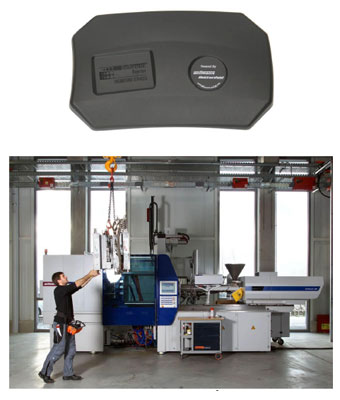| MAIN |
CELLMOULD® foaming technology produces light-weight, striation-free visible parts| Subj: Press-releses  With variothermic mold tempering, special mold inserts, high-precision opening and CELLMOULD® technology, successful series production of foamed light-weight parts for visible applications has become possible. For further testing, SCHAUMFORM has now installed the technology combination presented for the first time at the K 2013 in its own processing lab. With variothermic mold tempering, special mold inserts, high-precision opening and CELLMOULD® technology, successful series production of foamed light-weight parts for visible applications has become possible. For further testing, SCHAUMFORM has now installed the technology combination presented for the first time at the K 2013 in its own processing lab.Plastic components turn out much lighter when produced by a foam injection molding process. This is extremely important for the automotive industry, since any part weight savings lead directly to lower fuel consumption and consequently a reduction in CO2 emissions. Accordingly, many components are now being tested to see whether foam injection-molded parts can be used in future to replace conventional compact parts. Components not visible on the finished vehicle can already be produced directly as foam injection-molded parts without much difficulty. However, another barrier must be overcome besides successful foam injection molding, where injection-molded parts are visible, as is the case in vehicle interiors with cockpit components or pillar linings. Such parts must look exactly like compact components on the outside, in particular the visible surface must be completely free of striations. On a technology showpiece which was presented to the public for the first time at the WITTMANN BATTENFELD booth during K 2013, SCHAUMFORM demonstrated that it is possible to master this challenge, too. Apart from using the right material, though, this requires a combination of several technical solutions which must be well coordinated with each other. The core component of the exhibit was an all-electric EcoPower injection molding machine with 240 t clamping force and a special equipment package for this product. The moving platen was fitted with a high-precision opening function realized with a toggle. A CELLMOULD® foam injection unit with a 55 mm screw diameter was mounted on the fixed platen. During the plasticizing process, the nitrogen required as foaming agent is injected directly into the injection cylinder. Consequently, CELLMOULD® is a physical foaming process with gas injection straight into the melt. SCHAUMFORM developed and supplied a mold for the technology showpiece, which was designed for foam injection molding with high-precision opening, and in particular for variothermic tempering of the mold insert on the visible side of the part. Immediately before injection, the mold insert is heated by pressurized water at temperatures of up to 180° C. In this way, if the process is applied correctly, components are produced without any striations on the visible surface. The mold insert is subsequently cooled and simultaneously opened slightly with high precision, which has the effect of almost doubling the wall thickness of the molded part. This results in a fine, light foam structure inside the part. Mobile elements inside the mold also guarantee that the geometry of all surfaces which are important for the design and function of the part is precisely and correctly formed. The cycle time is hardly any longer in spite of the rather complex tempering technology, thanks to a mold insert made of a special material, valve stations placed close to the mold and temperature controllers tailored to fit this technology showpiece. The foam injection molding machine from WITTMANN BATTENFELD with CELLMOULD® technology was re-installed at the technical lab of SCHAUMFORM immediately after K 2013. There, some other thermoplastic materials are now being tested for automotive interiors, and alternative grades of steel for variothermic mold tempering as well. The versatile test mold from SCHAUMFORM combined with CELLMOULD® machine technology is also being used to carry out various tests commissioned by customers. The cooperation partners wish to thank BASELL for supplying the test material required for the trade fair free of charge. Source: WITTMANN BATTENFELD Previous news |
© 2002—2025 PLASTINFO